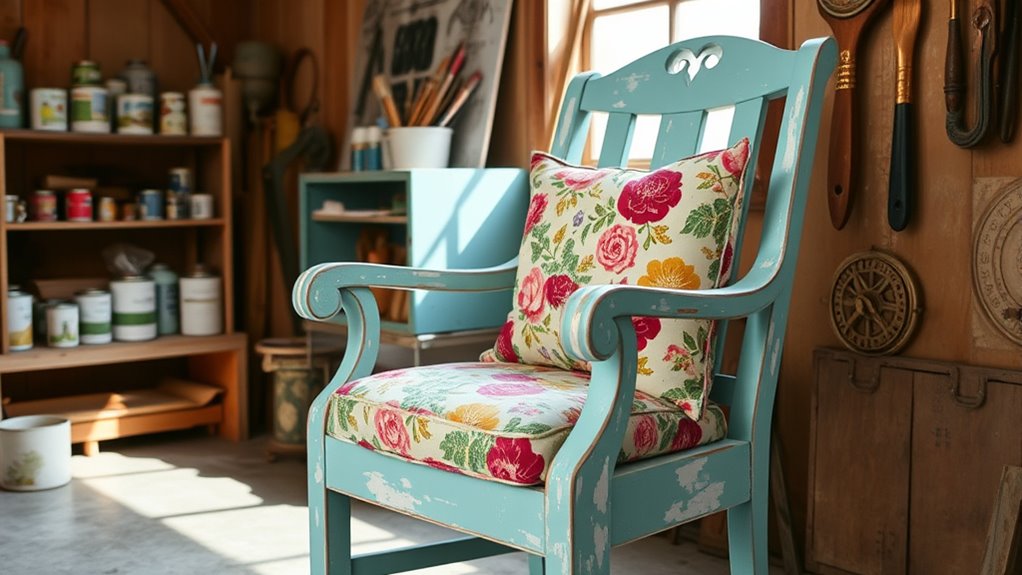Upcycling furniture is a fantastic way to save money, reduce waste, and create personalized home decor. By choosing sturdy pieces and giving them a fresh coat of paint, new hardware, or creative finishes, you can transform old items into stylish, functional pieces. Incorporating decorative touches and sustainable materials makes your project eco-friendly and unique. Keep exploring to discover simple techniques, inspiring project ideas, and eco-conscious tips that’ll help you craft beautiful furniture with purpose.
Key Takeaways
- Select sturdy, interesting furniture pieces and thoroughly clean and prepare surfaces for effective upcycling.
- Use creative techniques like painting, distressing, and adding hardware to personalize and enhance furniture.
- Incorporate sustainable materials such as reclaimed wood and eco-friendly paints to promote environmental benefits.
- Add decorative elements like textiles, hardware, or handcrafted accents to reflect your style.
- Maintain and protect your upcycled furniture regularly with gentle cleaning and sealants for longevity.
Benefits of Upcycling Old Furniture
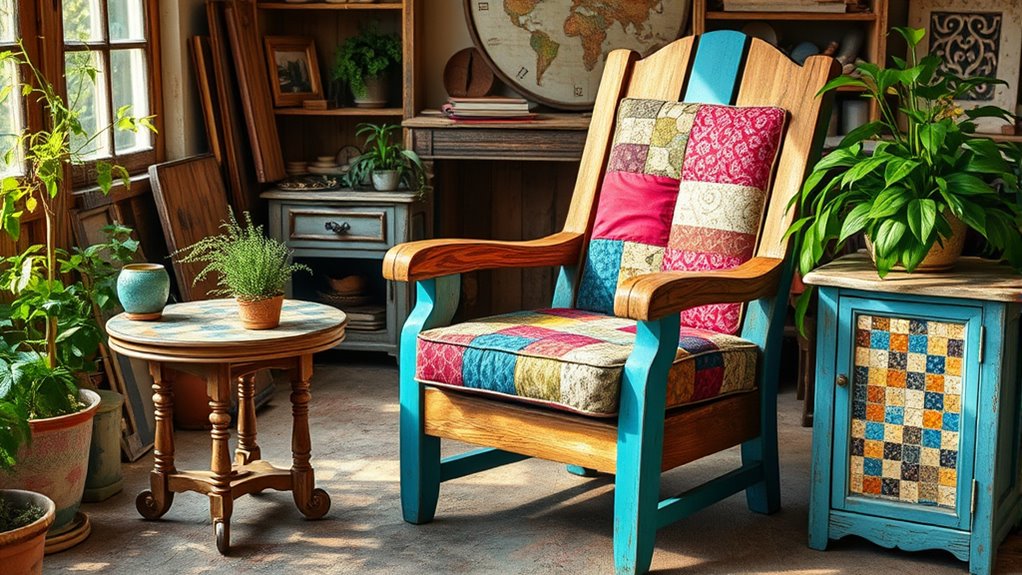
Upcycling old furniture offers numerous benefits that make it a smart choice for both your space and the environment. When you breathe new life into worn pieces, you create unique, personalized decor that reflects your style. It’s often more affordable than buying new furniture, saving you money while reducing waste. Upcycling also helps minimize your environmental impact by diverting items from landfills and reducing demand for newly manufactured furniture. Data-driven marketing strategies can be employed to showcase your upcycled pieces and reach a wider audience. Plus, it gives you the satisfaction of transforming something old into something beautiful and functional. The process encourages creativity and resourcefulness, allowing you to experiment with colors, finishes, and techniques. Overall, upcycling not only enhances your home’s aesthetic but also promotes sustainability and mindful consumption.
Choosing the Right Pieces to Upcycle

Choosing the right furniture pieces to upcycle is key to creating satisfying results. Start by selecting sturdy items with clean lines and minimal damage. Avoid pieces with extensive structural issues or deep stains, as they’ll be difficult to restore without extensive repairs. Look for furniture with interesting shapes, unique details, or vintage charm that you can enhance. Consider the piece’s size and how it fits into your space—small tables or chairs often work well for beginners. Think about your skills and resources, choosing items that match your comfort level with certain techniques. Additionally, understanding space efficiency can help you select pieces that maximize your available area and functionality. Incorporating cultural intelligence insights can also guide you in choosing styles that resonate with your personal or local aesthetic. Analyzing the safety of electric heated mattress pads can inspire you to include elements that promote comfort and safety in your decor. Moreover, exploring self watering plant pots can be beneficial if you want to add low-maintenance greenery to your upcycled furniture setup. Ultimately, pick pieces that inspire you and align with your decorating goals. Well-chosen furniture will make your upcycling project more enjoyable and result in a piece you’re proud to display. Upcycling skills can help you transform even challenging pieces into beautiful, functional decor.
Essential Tools and Materials for Upcycling
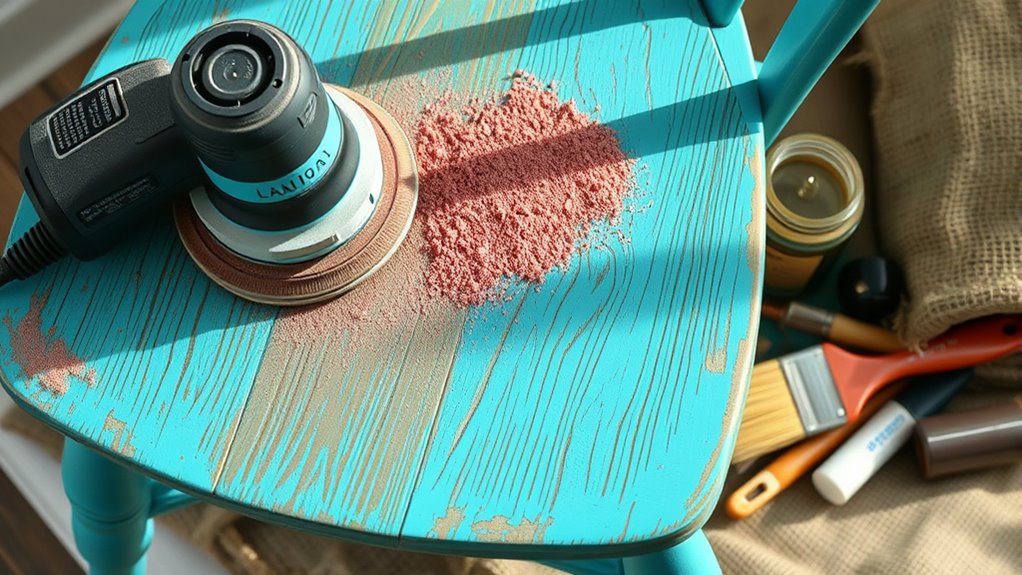
Before you start upcycling, make sure you have the right tools and safety gear. Wearing protective equipment like gloves and goggles keeps you safe during messy or sharp tasks. Basic tools such as sanders, screwdrivers, and paintbrushes are essential for preparing your furniture. Additionally, understanding upcycling techniques can help you achieve better results and reduce waste. Proper ventilation and the use of safety precautions are crucial when working with paints and adhesives to avoid harmful fumes. Furthermore, understanding retirement planning strategies can help you budget effectively for your project and ensure you have the necessary resources. Being aware of cheating and related issues can also inform how you handle personal boundaries and trust in collaborative projects or shared spaces. Incorporating sustainable practices into your upcycling process can further enhance your eco-friendly efforts.
Safety Gear and Protective Equipment
Safety gear and protective equipment are essential when working on upcycling projects, as they help prevent injuries and guarantee a safe working environment. Protecting yourself should always come first, especially when handling tools and chemicals. Here are three key items you need:
- Safety goggles – Shield your eyes from dust, splinters, and chemical splashes.
- Dust mask or respirator – Protect your lungs from fumes, dust, and airborne particles.
- Work gloves – Guard your hands against splinters, sharp edges, and paint or stain chemicals.
Wearing the right safety gear keeps you safe and allows you to focus on transforming furniture without worry. Always check your equipment before starting, and replace any damaged items to guarantee maximum protection.
Basic Tools for Preparation
Having the right tools on hand is essential to preparing furniture effectively for upcycling. You’ll need basic items like sandpaper or a power sander to remove old paint or finish, creating a smooth surface. A putty knife helps fill in cracks or holes, ensuring a flawless finish. A screwdriver or drill is necessary for removing hardware, making disassembly easier. Painter’s tape is useful for protecting areas you don’t want to paint or stain. A clean cloth or tack cloth helps wipe away dust and debris after sanding. Additionally, a drop cloth or plastic sheeting protects your workspace from spills. Using high-quality tools can make your project more efficient and provide better results. It’s also helpful to familiarize yourself with local regulations regarding disposal of old paint or finishes to ensure environmentally responsible practices. Incorporating sound science principles, such as proper preparation, can significantly improve your upcycling outcomes. For example, understanding how paint viscosity affects spray application can help you choose the right tools and techniques. Moreover, understanding how industry transformations impact material availability can help you select sustainable and cost-effective options. With these tools, you’ll be well-equipped to prep your furniture efficiently, setting the stage for a successful upcycling project.
Step-by-Step Guide to Preparing Your Furniture
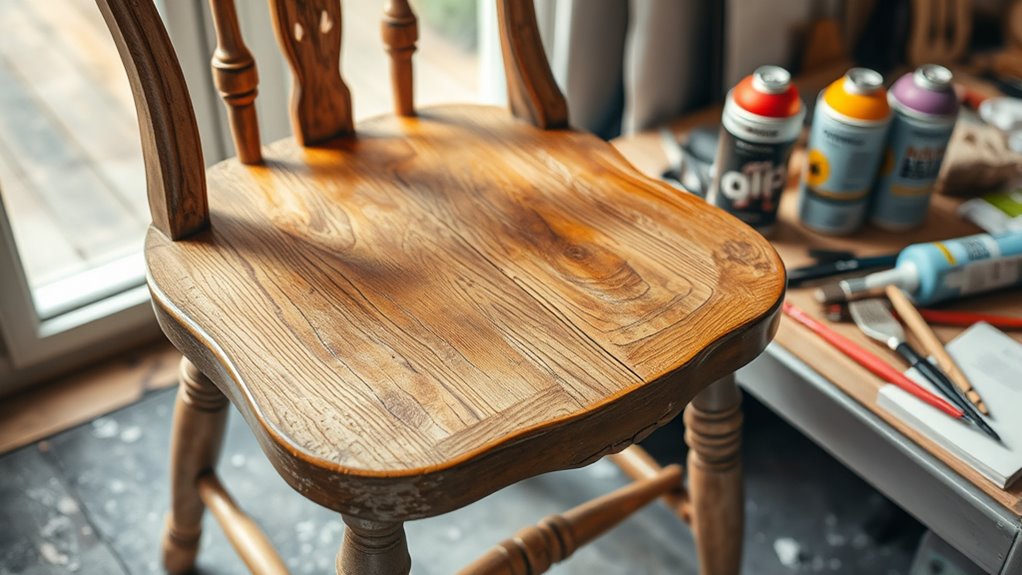
Start by thoroughly cleaning your furniture to remove dirt and grime. Then, sand the surface to create a smooth, even base for your paint or finish. If needed, repair any damage and apply a primer to guarantee your upcycling project lasts. For the best results, use a high-quality juicing method to ensure maximum extraction of nutrients and a smooth finish.
Clean and Sand
Are you ready to guarantee your furniture is perfectly prepared for upcycling? First, clean the surface thoroughly to remove dust, grease, and dirt. Use a damp cloth and mild soap if needed, then let it dry completely. Next, sand the furniture to create a smooth, even surface that helps paint or stain adhere better. Start with medium-grit sandpaper, then switch to fine grit for a polished finish. Here’s how to do it:
- Remove loose paint or old finish with a scraper or coarse sandpaper.
- Sand in the direction of the wood grain to avoid scratches.
- Wipe away dust with a tack cloth or damp rag before moving on.
- Incorporate proper surface preparation techniques to ensure your upcycling project lasts longer and looks professionally finished. Additionally, using the right sanding tools can make the process more efficient and result in a better finish.
Taking these steps ensures your furniture is clean, smooth, and ready for the next phase of your upcycling project.
Repair and Prime
Wondering how to guarantee your furniture is truly ready for a fresh coat of paint or stain? First, inspect for any damage or loose parts. Repair cracks, chips, or loose joints with wood filler or glue, then sand smooth once dry. Next, prime the surface to ensure paint or stain adheres evenly. Use a quality primer suited for your furniture’s material, applying it with a brush or roller in thin, even coats. Allow the primer to dry completely before sanding lightly to smooth out any brush strokes or drips. Priming not only improves adhesion but also helps hide imperfections. Once primed and smooth, your piece is prepared for the final painting or staining, resulting in a flawless, professional-looking finish.
Creative Painting and Finishing Techniques
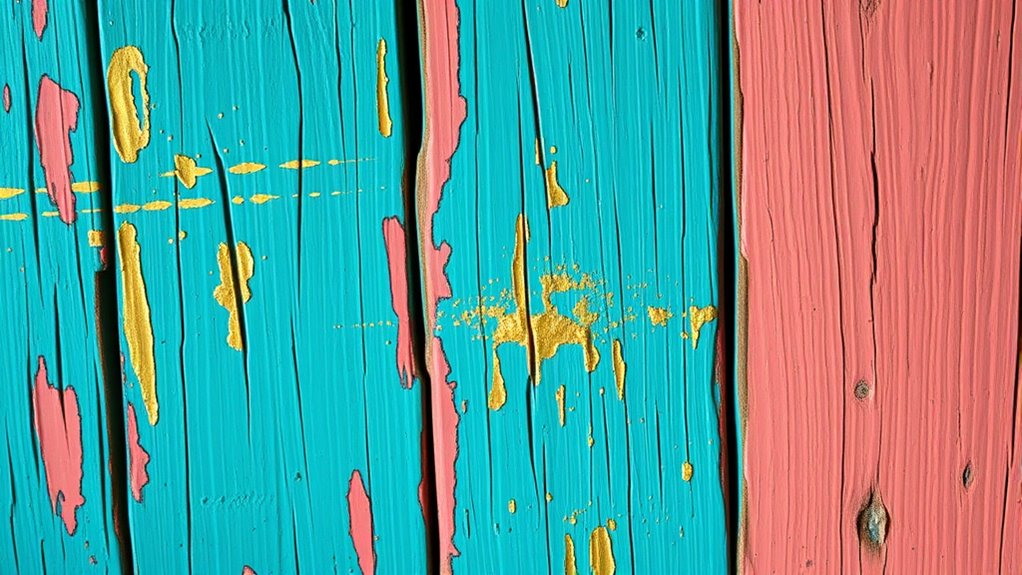
Creative painting and finishing techniques can transform plain or outdated furniture into striking focal points. By adding unique textures, colors, and finishes, you personalize your pieces and give them a fresh look. Here are three techniques to try:
Transform your furniture with creative painting techniques for a personalized, fresh look.
- Dry Brushing: Lightly brush over the surface with a dry brush to create a weathered, rustic effect that highlights the wood grain. This technique is especially effective when combined with natural materials like wood to enhance farmhouse charm. Utilizing paint finishes can further customize the look and feel of your furniture.
- Chalk Paint: Use chalk paint for a matte, smooth finish that’s easy to distress for a shabby chic vibe. Incorporating vintage decor elements can complement this finish beautifully.
- Decoupage: Adhere decorative paper or fabric to the surface, then seal it with a clear topcoat for a custom design. Utilizing patterned fabrics or paper can add a personalized touch that aligns with farmhouse aesthetics decorative accents.
– Incorporating finishing techniques like distressing can further enhance the aged, vintage appearance of your furniture. Experiment with these methods to make your furniture truly stand out and reflect your style.
Repurposing Furniture for Functional Use

When you choose versatile furniture pieces, you can transform your space more easily. Incorporating multi-functional designs lets you maximize functionality without sacrificing style. Plus, enhancing storage solutions helps keep your area organized and clutter-free.
Choosing Versatile Pieces
Choosing versatile furniture pieces is essential for maximizing both space and functionality in your upcycling projects. When selecting items, focus on pieces that can serve multiple purposes or adapt easily to different roles. For example, a fold-out sofa bed offers seating by day and a bed by night. A storage ottoman functions as a footrest, extra seating, and hidden storage. A sturdy wooden ladder can be repurposed as a shelving unit or towel rack. These versatile pieces save space and add practicality to your home. Look for furniture with adjustable features, hidden compartments, or adaptable structures. By choosing adaptable pieces, you create a flexible environment that’s easy to customize as your needs change, making your upcycling efforts both functional and stylish.
Incorporating Multi-Functional Designs
Incorporating multi-functional designs transforms simple furniture into versatile assets that maximize your space and utility. By repurposing pieces, you create furniture that serves more than one purpose, saving space and adding style. For example, a coffee table with built-in storage or a bed with drawers underneath offers practicality without clutter. Think creatively to combine functions—like turning an old ladder into a bookshelf or a vintage trunk into a coffee table with storage. These ideas make your space more efficient and personalized.
| Functionality | Furniture Example |
|---|---|
| Storage | Ottoman with hidden compartments |
| Seating & Storage | Bench with built-in shelves |
| Workspace | Fold-out wall desk |
| Decor & Utility | Repurposed dresser as a bar |
Enhancing Storage Solutions
Repurposing furniture is an effective way to enhance your storage solutions while adding character to your space. You can transform old pieces into practical storage units that suit your needs. For example:
- Turn a vintage ladder into a quirky bookshelf, giving your living room a rustic charm.
- Convert a large wooden crate into a coffee table with hidden storage for magazines and throws.
- Repurpose a dresser into a versatile kitchen island with extra drawers for utensils and gadgets.
Incorporating Decorative Elements and Personal Touches
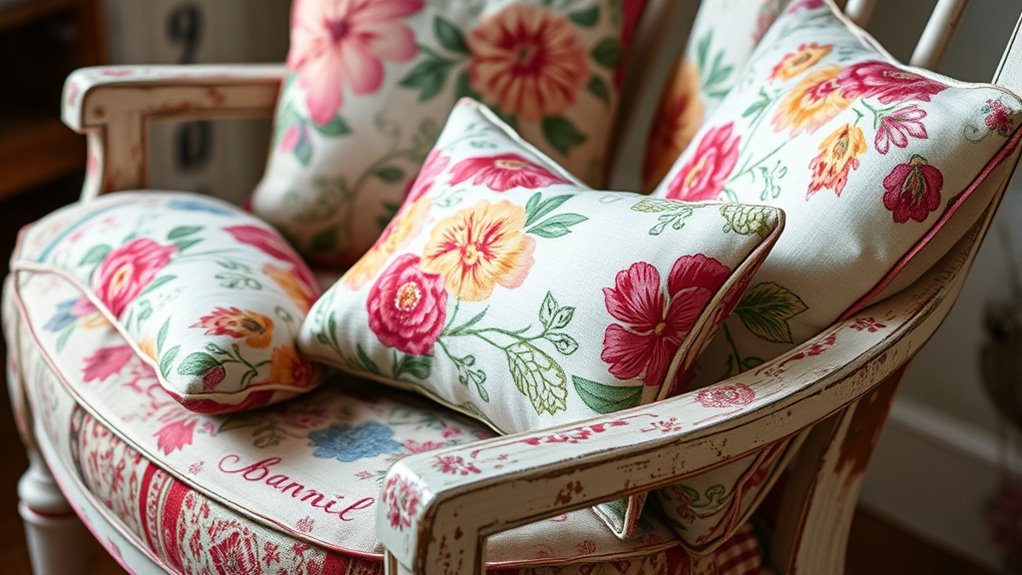
Adding decorative elements and personal touches can transform a simple upcycled piece into a unique statement. You might add vintage hardware or colorful knobs to give furniture personality. Painting patterns, stenciling designs, or applying decals can make your piece stand out. Incorporating textiles like fabric seat cushions or upholstered panels adds comfort and visual interest. Personal touches, such as family photos, meaningful quotes, or handcrafted accents, make your furniture truly yours. Don’t be afraid to mix textures, colors, and styles to reflect your personality. The goal is to create a piece that resonates with your taste while showcasing your creativity. These small details turn a basic upcycled item into a conversation starter and a reflection of your unique style.
Tips for Maintaining Your Upcycled Creations

Once you’ve personalized and decorated your upcycled furniture, keeping it looking its best requires some simple maintenance. Regular care helps preserve your hard work and keeps your pieces vibrant. Here are three tips to maintain your creations:
- Clean gently: Use a soft cloth and mild soap solution to wipe surfaces regularly, avoiding abrasive cleaners that could damage the finish.
- Protect surfaces: Place coasters, placemats, or pads under hot or wet items to prevent scratches, stains, and water damage.
- Reapply finish: Periodically, add a fresh coat of sealant or wax to protect paint and wood, especially in high-traffic areas or if you notice dullness.
With these simple steps, your upcycled furniture will stay beautiful and durable for years to come.
Inspiring Upcycling Projects for Beginners

Getting started with upcycling can be both fun and rewarding, especially when you choose simple projects that don’t require extensive skills or tools. A great beginner project is transforming an old wooden chair by sanding, repainting, and adding new upholstery. This refreshes the piece and gives it a modern touch. Another easy idea is turning a vintage crate into a stylish storage ottoman—just clean, paint, and add a cushion. You can also upcycle a collection of mismatched picture frames by painting them in coordinating colors for a cohesive gallery wall. Repurposing a tired side table with a fresh coat of paint and new hardware can instantly elevate your space. These projects are manageable, quick, and give you a satisfying sense of accomplishment.
Sustainable Practices to Enhance Your Upcycling Efforts
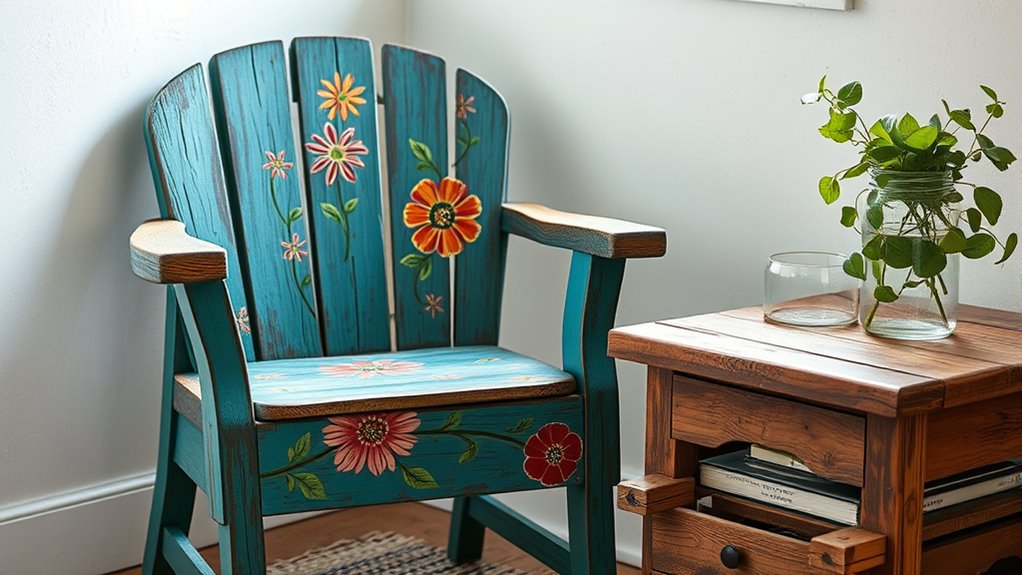
To truly maximize the environmental benefits of your upcycling projects, adopting sustainable practices is essential. First, always source materials responsibly—look for reclaimed wood, recycled paints, or leftover supplies to reduce waste. Second, choose eco-friendly products, like low-VOC paints and natural finishes, which minimize harmful emissions. Third, plan your projects carefully to avoid overbuying or wasting materials; measure twice, cut once. Incorporating these practices keeps your efforts green and efficient. Not only do you reduce your ecological footprint, but you also create unique, environmentally conscious furniture. By making mindful choices, you guarantee your upcycling journey is sustainable and impactful, inspiring others to follow suit. Sustainable practices aren’t just good for the planet—they elevate your craftsmanship and creativity.
Frequently Asked Questions
How Can I Ensure My Upcycled Furniture Is Durable and Long-Lasting?
To guarantee your upcycled furniture is durable and long-lasting, you should choose quality materials and proper techniques. Sand surfaces thoroughly before applying paint or sealant, and always use a primer for better adhesion. Seal your piece with a durable topcoat or polyurethane to protect against scratches and moisture. Regularly clean and maintain it, and avoid exposing it to extreme conditions, so your upcycled furniture stays beautiful for years.
What Are Eco-Friendly Paint Options for Upcycling Furniture?
Thinking of giving your furniture a fresh, eco-friendly coat? You can opt for natural paints like clay, milk paint, or plant-based options that are low in VOCs. These choices are gentle on the planet and safe for your home. Just like a painter’s brush transforms a blank canvas, these eco-friendly paints breathe new life into your furniture while protecting the environment. Go green and create beautifully durable pieces!
How Do I Choose the Best Upcycling Projects for Small Spaces?
When choosing the best upcycling projects for small spaces, consider items that maximize functionality and storage without cluttering. You might opt for compact furniture like a fold-away desk or multi-purpose pieces. Focus on projects that add vertical storage or clever organization to make the most of limited space. Keep in mind your style and needs, and select projects that bring both practicality and personality to your cozy area.
Can Upcycled Furniture Be Customized to Match Existing Decor?
Think of upcycled furniture as a blank canvas waiting for your design touch. Yes, you can customize it to match your existing decor by choosing paint colors, finishes, and hardware that complement your style. You might even add decorative details like stenciling or new upholstery. With a little creativity, your upcycled piece will seamlessly blend into your space, turning old into new while perfectly matching your decor’s personality.
What Safety Precautions Should I Take During the Upcycling Process?
When you’re upcycling furniture, safety should always come first. Wear protective gear like gloves, goggles, and a mask to guard against dust, fumes, and sharp edges. Work in a well-ventilated area, and keep a fire extinguisher nearby if you’re using paints or finishes. Use tools carefully, follow manufacturer instructions, and keep your workspace organized to prevent accidents. Prioritizing safety helps you enjoy a smooth, risk-free creative process.
Conclusion
Upcycling furniture is like planting a seed that blossoms into a unique masterpiece. With a little creativity and effort, you transform old pieces into treasures that reflect your style and values. Each project is a brushstroke in your personal gallery of sustainability and self-expression. Keep exploring, experimenting, and nurturing your skills—your upcycled creations will continue to grow and inspire, turning your space into a vibrant garden of eco-friendly beauty.
